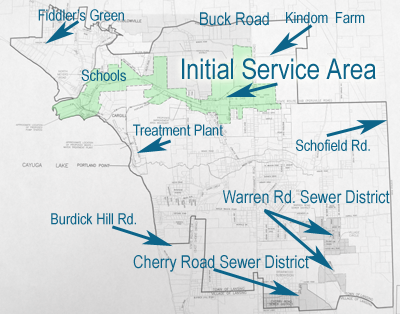- By Dan Veaner
- News
 Print
Print  Last month a Town Board vote on establishing a sewer district seemed imminent. But high costs to properties within the district caused the board and the Lansing Sewer Committee to look at a town-wide option that would have included the whole town with the exception of the Village of Lansing, which has its own sewer district. That would cut the cost of sewer by two thirds for those inside the initial service area, and would mean a nominal cost to others in the Town.
Last month a Town Board vote on establishing a sewer district seemed imminent. But high costs to properties within the district caused the board and the Lansing Sewer Committee to look at a town-wide option that would have included the whole town with the exception of the Village of Lansing, which has its own sewer district. That would cut the cost of sewer by two thirds for those inside the initial service area, and would mean a nominal cost to others in the Town.Wednesday engineer David Herrick suggested the Sewer Committee consider a third version, based on an old plan: a partial town-wide district the boundaries of which define a large area of the town that could realistically be sewered at some time in the future.
Herrick presented a map showing a potential sewer district that goes from Burdick Hill and Cherry Roads to the south up to Buck Road and Wilson Road to the north. This map was part of a study conducted for an inter-municipal sewer agreement crafted in 2003 by six communities, known as 'Group of Six,' made up of the City and Town of Ithaca, the Town of Dryden, Cayuga Heights and the Village and Town of Lansing. The map shows the Lansing segment of areas across the municipalities that were deemed to be reasonably sewerable.
He suggested that rather than charging all townspeople for sewer, a district be formed to include only those areas that may realistically receive service in the future. In this scenario sewer would initially be provided in the area originally envisioned for the current incarnation of the project. A tiered fee schedule would apply within the larger district, depending on the level of benefits in each area.
Historically Lansing has been trying to find a way to bring sewer to the Town for nearly a quarter of a century. Originally the plan was very similar to the most recent one, featuring a standalone plant located near Cargill and portland Point. But a change in NYS Department of Environmental Conservation (DEC) rules forced Lansing into an inter-municipal agreement with five other communities that would require the town to deliver effluent to the Cayuga Heights Treatment Plant, with overflow going to the Ithaca plant.
In 2007 an unpopular project that would have required an expensive trunk line from the Town through the Village of Lansing to the Cayuga Heights plant died before it was even brought to the public for a vote, largely because it would have been too expensive. The most recent project includes a new stand-alone plant, made possible by another change by the DEC -- they now agree that Lansing can build its own treatment plant.
Herrick showed the committee a 1998 map showing a sewer district virtually identical to the map taken from the inter-municipal agreement. Committee members liked Herrick's approach because it is already documented and defensible as a potential sewer area. Committee member Andy Sciarabba said that a benefit of the larger district is that it clearly protects agricultural lands to the north, which has always been a major goal of the various incarnations of the sewer committee and town officials.
 This map is based on studies conducted when the 'Group Of Six' Intermunicipal Sewer agreement was formed. It shows the area of the Town of Lansing that has a reasonable potential for future municipal sewer service.
This map is based on studies conducted when the 'Group Of Six' Intermunicipal Sewer agreement was formed. It shows the area of the Town of Lansing that has a reasonable potential for future municipal sewer service.At the end of October the Town Board was ready to vote on a public interest order that would have started the process of forming a sewer district that would have been paid for entirely by residences and businesses inside the sewer district. In the 11th hour Town Attorney Guy Krogh suggested the board consider a town-wide option.
Lansing Supervisor Kathy Miller says that makes sense because everyone in the town will benefit from sewer. The committee has yet to produce a solid list of benefits that would offset a nominal property tax for district residents outside of the initial service area. Among those being considered are reduced cost to the schools and town (which presumes less tax for sewer expenses), denser mixed use development that will add to the tax base, offsetting tax revenue losses from the power plant and presumably lower taxes for individuals. Miller adds that some farmers would gladly pay something for sewer to keep denser development away from their farms, among other town-wide benefits.
Krogh noted that the Town of Ithaca has a town-wide water and sewer district that could serve, in part, as a model for Lansing. Sewer Committee Member Noel Desch, who was Ithaca Town Supervisor when that district was put in place, noted that Ludlowville would present similar problems to those faced by Forest Home. He said the geology of the neighborhood made sewer so difficult and expensive there that it would never have gotten service if a grant hadn't been obtained to pay for it.
Before a partial town-wide approach is solidified the committee has a lot of details to work out. Discussions Wednesday centered on whether existing town sewer districts would be merged into the larger district. That could be of benefit to the Warren Road district, which is paying off construction debt, but could be a problem for the Cherry Road district, which is debt-free. But Herrick noted that the Cherry Road system is aging and being part of a larger district could benefit it in the long run by providing a bigger operation and maintenance (O&M) pool of funding to replace worn out pipes.
There is also the matter of the cost of bringing service to new neighborhoods within the district. Sciarabba said that adding that cost to overall district charges wouldn't necessarily raise costs for existing service area properties if they are added at strategic points in the debt service repayment schedule. Additionally, developers of new projects could be required to pay for infrastructure, ultimately reducing the cost to existing service area properties by increasing the number of properties paying for sewer without increasing the cost to the district.
Another issue is the Group of Six's inter-municipal agreement, which directly impacts the Cayuga Heights plant's customer base. Miller says in a meeting with plant representatives earlier Wednesday they said they consider the inter-municipal agreement a contract to use the Cayuga Heights plant, although it was unclear whether that refers exclusively to existing districts or the larger future one. Desch said it will be important to iron out these issues with Cayuga Heights before submitting the project to the State Comptroller for review.
The Committee agreed on Herrick's suggested district boundaries, noting that the initial service area boundaries would not change from those presented in the version of the project that would have been paid for entirely by those in the benefit area. The project would be paid for by properties within the much larger district in a tiered system with people getting sewer immediately paying the most and those least likely to get it the least.
They directed Herrick to gather information on the properties within the new boundaries so that Sciarabba can begin modeling the costs to individual properties.
Officials say town-wide solutions are being considered to provide a fair and affordable solution that will meet long-standing town objectives, including the creation of a town center, protecting the character of the town and agricultural lands. If work on the new plan continues without setbacks, committee members estimate a sewer in the initial service area could be completed by December 2015.
v8i44
